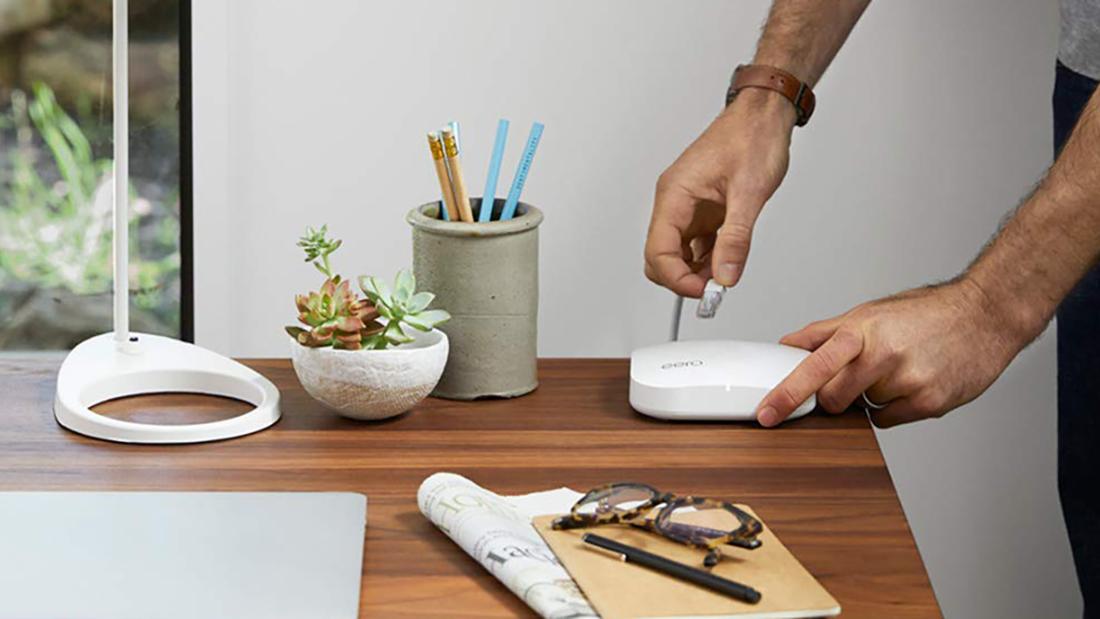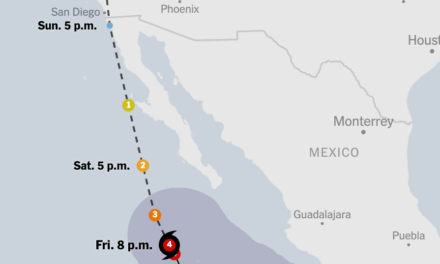
We spent months testing mesh Wi-Fi routers and the Eero 6 is the best

CNN —
As the amount of devices under your roof continues to tick up — phones, tablets, cameras, TVs, computers, game consoles, e-readers and smart appliances — a router that can handle all sorts of connections at once is all too important. Your best bet to ensure optimal performance: a mesh Wi-Fi router, which instead of utilizing a single router is composed of a main router along with multiple nodes you can place throughout your home to effectively eliminate dead zones and improve wireless internet speeds.
After months of testing mesh routers to find the best of the best, we found one that rises to the top.
Best mesh Wi-Fi router
With its foolproof setup process, nearly unrivaled speeds and coverage areas, Eero 6 is your best bet when opting for a mesh router. It’s an investment but one that will last for several years, thanks to the latest standards being supported inside.

EERO
There’s a lot to love about the Eero 6. It blankets wide spaces with unfaltering coverage and pairs with a helpful companion app, and its straightforward setup make it a great choice even for a tech-challenged user.
Of all the mesh routers we tested, the Eero 6 was the simplest to set up, as the Eero app’s guidance is unfettered by tech jargon. No sludging your way through obscure acronyms here. Throughout the process, the app (available for Apple and Android) provides helpful prompts to ensure you have all needed materials, and a support page even features photos to guide you through setting up the main router. Once that’s done, the app is along for the ride while placing the individual nodes (you can opt for two extenders or two routers). After you find a spot and plug in a node, the Eero app will score your placement, giving you data and helping you decide if you need to find another spot, truly making it simple for anyone to expand their Wi-Fi coverage.
Once we had the Eero set up (we tested the three-pack Eero, which includes the main router and two nodes, also called extenders), we went about our daily lives. We sent messages and took calls (both audio and video) from a variety of devices. We caught up on our favorite content, including “WandaVision,” reruns of “The Office,” “The Mandalorian” and “Below Deck.” We gamed until our hands strained.
With more than 100 devices on the network (from smart bulbs to TVs, laptops to connected appliances), the Eero 6 never once so much as sputtered during our testing, nor did we notice the smallest of dead spots. While the main router alone has enough juice to cover 1,500 square feet, pairing it with the two extenders covers a radius of 5,000 square feet. Whether it was in a 1,050-square-foot apartment or a three-story, 2,000-square-foot home, the Eero outperformed the other mesh routers in our pool. It was the only setup, for instance, that expanded coverage in the home past the walls in which we placed it, giving us Wi-Fi in the garage, backyard and front yard.
The Eero 6 boasts dual-band coverage. Essentially, dual-band coverage can be considered in terms of a highway: Instead of all your devices sitting in traffic on a single-lane highway leading to slowdowns, dual-band expands the highway to two lanes, allowing for devices to switch between the two depending on which lane is moving faster. If you opt to turn on “Band Steering” in the Eero app, the mesh system can perform a bit of traffic control, monitoring your connected devices and intelligently switching them between the bands.
The main Eero 6 router supports speeds up to 900 Mbps (megabits per second; the higher the number, the faster the speeds), but when used with the extenders, the maximum speed is about 500 Mbps. It’s not by any means a slouch, but if you’re paying for faster speeds from your service provider, it makes sense to jump to the Eero Pro 6, which can handle a full gigabit even with multiple nodes. In our testing, the Eero 6’s speeds were topped only by much more expensive models, and even so, those differences were negligible. Our download speeds averaged to around 200 Mbps, which you’ll notice when streaming content as buffering becomes a thing of the past even for 4K resolution videos. Upload speeds also averaged about 200 Mbps to 250 Mbps, which meant no slowdowns when sending emails, uploading files or posting on Instagram.
Devices with a Wi-Fi 6 antenna inside — iPhone 12 and Galaxy S21 phones — consistently clocked in higher in terms of speed. With this standard appearing on more and more devices, you’re future-proofed by opting for the Eero 6.
Since Eero is owned by Amazon, you can turn on Amazon Connected Home features, which allow for easy setup of devices like Echo smart speakers or displays, Fire TV streamers and Kindles. With a Zigbee antenna inside — a connection standard for smart home devices like smart plugs, cams and sensors — the Eero 6 can also act as your home’s smart home hub, with easy integration with Alexa and Echo devices. When you want to add a Zigbee wall plug to your home, for instance, you don’t need to buy a hub or open up another app.
Through the Eero app, you can opt for Secure or Secure+ (monthly plans priced at $2.99 and $9.99, respectively). Notably, this unlocks parental controls, allowing you to block specific sites or a category of content on the web while also protecting against network threats and ad blockers. Opting for Secure+ gives you a 1Password Family license, an Encrypt.Me VPN subscription and a MalwareBytes account.
All in all, the Eero 6, with its foolproof setup process, nearly unrivaled speeds and coverage areas, is your best bet when opting for a mesh router. Priced at $129.99 for one or $279 for a three-pack, it’s an investment but one that will last for several years, thanks to the latest standards being supported inside.
We crafted our testing pool based on current Wi-Fi standards, top-rated mesh routers and our own expertise with products on the market. We then designed testing categories that would make for a fair comparison across all routers.
Once each router arrived, we began our analysis by examining everything from the packaging and labeling of the hardware to the included instructions. We also paid close attention to what interface we had to use for setup, determining if it was a web page to visit, a desktop app or a purely mobile experience. When it came to placing the router, we noted if the onboarding process helped by suggesting where the router and each node should be placed and tested the connection strength afterward.
After we set up the network, we took a look at the included features. For instance, are parental controls available out of the box, or did we need to sign up for a monthly plan? What type of security protocols and protections were in place from the get-go?
We then conducted a number of speed tests and benchmarks to test connectivity in a quantitative format. After those benchmarks, we measured the performance in a qualitative manner with our everyday workflows on a plethora of devices. We also stress-tested with more than 100 devices on the network at any given time. In the realm of smart home, we looked at what extra connectivity was included inside the router.
Asus ZenWiFi AX XT8 ($442.40; amazon.com)
Without a doubt, the ZenWiFi AX (XT8) is the most advanced mesh networking system we tested. And Asus has taken the kitchen sink approach here — it’s a tri-band system with a single lane for 2.4 GHz and two lanes for 5 GHz. You can opt to broadcast a single network, combining all three bands, or split them up if you want to decide which network a device connects to. Additionally, the XT8 offers a built-in VPN that will keep your coffee shop Wi-Fi sessions safe and allow you to access your home network. It also works with Amazon’s Alexa platform, or you can create automations with the website If This Then That (IFTTT).
The XT8 will block malicious sites, allows for parental controls and will even let you designate which device or content types should be prioritized across your home network. Each access point supports an external hard drive for network access, which, if combined with VPN features, will put your files at your fingertips no matter where you are.
Our lone complaint about the XT8 has nothing to do with performance but rather the overall interface for managing the network. There are so many options; this system is clearly designed for someone who is comfortable with managing a network, and even then it’s still somewhat intimidating.
Asus sells the XT8 in two-packs for $449, making it the most expensive setup we tested.
Eero (starting at $199; amazon.com)
In terms of its feature set, the Eero, originally known as the “all-new Eero” (in 2019), is pretty similar to our top pick, the Eero 6. It has a slightly bulkier design, lacks the Zigbee antenna for easy smart home connectivity and, most importantly, is missing Wi-Fi 6 support. At only $80 more for a three-pack, it makes sense to spend the extra for the latest-generation router.
Eero Pro 6 (starting at $599; amazon.com)
The Eero Pro 6 is the step-up model from the Eero 6. Aside from a shorter and wider design, it has a few other pro features. Notably, this supports gigabit speeds (aka 1,000 Mbps) on upload and download in a mesh configuration. If you’re paying for those speeds, like with Fios Gigabit, it makes sense to pay the extra and opt for the Pro 6.
It also has a bit more room for devices to connect with a tri-band setup. That means it has a three-lane highway versus a two-lane setup on a dual-band router. In total, the Eero Pro 6 features a single 2.4 GHz band and two 5 GHz bands. It’s a noticeable difference if you have more than 100 data-heavy devices connected all at once.
Lastly, if you’re a power user who depends on a hardwired connection, each Eero Pro 6 features two Ethernet ports on the back. And that’s something the core Eero 6 just can’t match. But for everyday users, the cheaper Eero 6 will be more than enough.
Google Nest Wi-Fi ($349.99; target.com)
Google’s Nest Wi-Fi mesh networking system used to be the gold standard of mesh systems: It’s incredibly simple to set up and manage, with everything done directly in the Google Home app. You can bundle devices into groups and set access schedules, or pause Wi-Fi access on demand through the app or by telling Google Assistant.
You can also use those same groups to block access to inappropriate websites. From the initial setup process to more advanced controls, using Nest Wi-Fi is very easy and meant for those who aren’t all that tech-savvy. It’s truly a set-it-and-forget-it mesh networking system.
Each Nest Wi-Fi access point acts as a Google Home device, meaning you can use the wake phrase of “OK/Hey Google” to ask questions and control your smart home devices.
However, Nest Wi-Fi currently doesn’t have a Wi-Fi 6-capable version, so if you’re looking for a system that will future-proof your Wi-Fi network, the Eero 6 is a superior option. Ultimately, that’s what held Nest Wi-Fi back from being our top pick.
Linksys Velop MX4200 ($498.99; amazon.com)
The Velop MX4200 is Linksys’ latest Wi-Fi 6 mesh networking system, and it’s an impressive setup. It was tested with a gigabit connection, and when conducting speed tests within a few feet of an access point, we often saw speeds over 700 Mbps.
Three access points cost $499, putting it at the higher end of the systems we tested. However, you gain the performance boost and features like support for network hard drives, support for up to 2,404 Mbps on Wi-Fi 6 and three gigabit LAN ports on each access point.
You can tell the system to prioritize a device if you need to ensure you don’t break up during a video call, for example, or if you want to be certain your gaming session is getting all the bandwidth it needs. You can also set up basic parental controls, like pausing internet access on a specific device, setting a schedule or blocking specific websites.
Where the MX4200 fell short in our testing was with its lack of support for smart home services, advanced parental controls and price. Linksys plans on adding support for its Shield subscription service, which allows better site blocking and content filtering by age, and Aware, a subscription service that uses Wi-Fi signals to track motion in your home, along with HomeKit networking support in the second half of 2021. Once those features are added, the AX4200 will better compete with the likes of the Eero 6.
Netgear Orbi AX600 ($952.30, originally $999.99; amazon.com)
The Netgear Orbi AX600 is a state-of-the-art router — it’s bundled with the latest Wi-Fi 6 standards and features some smart home connectivity. But you’re paying a lot of money for the AX600: $999 for a two-pack.
For that price, it’s a tri-band experience and 6 Gbps-capable router (which translates to 6,000 Mbps in total). But you’ll need a really fast connection from your service provider to deliver that. Given this router’s high price point, you’re much better off opting for the Eero 6.
Netgear Orbi AX1200 ($157.99, originally $199.99; bhphotovideo.com)
The entry-level Orbi AX1200 from Netgear is a bare-bones mesh system that features a neat geometric design pattern on small square routers. Like the Eero 6, it’s a dual-band system that can cover 4,500 square feet of space, slightly less than what our top pick can deliver. In our testing, it was about 50 Mbps to 75 Mbps behind the other routers we tested, and it doesn’t feature Wi-Fi 6 support.
Like the Eero and SmartThings Wi-Fi, there’s a companion Orbi app that hides a majority of security and parental control features behind a monthly plan. Netgear has partnered with Circle for parental controls here. For the price and the performance we experienced, the Eero 6 makes much more sense.
Samsung SmartThings Wi-Fi ($229.95; amazon.com)
Samsung’s SmartThings Wi-Fi launched in late 2018 and hasn’t received a hardware update since. The real highlight of the SmartThings Wi-Fi system, outside of its mesh networking capabilities with support of up to 32 different hubs (yes, you read that right, 32) is that it doubles as a smart home hub for the SmartThings platform.
That means you can use it to connect to and control any product or service that works with SmartThings, such as the recently added Nest product line, along with countless other accessories and devices. SmartThings Wi-Fi has support for Zigbee and Z-Wave protocols, allowing compatible devices to connect directly to the hub, adding to its feature set.
As for its Wi-Fi capabilities, you get free access to the Plume app, which provides access to more advanced Wi-Fi controls and mesh networking features. But despite the capabilities of Plume’s networking features, it’s also a drawback of SmartThings Wi-Fi because you’re forced to use two different applications to manage your home network, with each one offering different settings.
We hope that Samsung updates SmartThings Wi-Fi with modern features and connection speeds, because its smart home features and platform are some of the best for a mesh networking system.
Vilo Mesh Wi-Fi System ($69.98; amazon.com)
A three-pack of Vilo’s mesh Wi-Fi system is priced incredibly low at $70 and does a good job of covering your space in Wi-Fi. It’s a system designed for basic internet use and streaming, and not for a household with multiple online gamers or 4K streams. The Vilo app is basic and frustrating at times, but once your system is set up, you shouldn’t have to spend too much time using the app. If you need a bare-bones network and don’t want to spend a ton, Vilo surely gets the job done.
Read more from CNN Underscored’s hands-on testing:
Source: http://rss.cnn.com/~r/rss/cnn_topstories/~3/VmJfT16vjPA/index.html


















